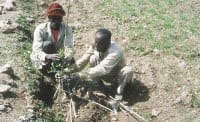Waaqayyo Muudaa used to herd cattle and camels in the vast grazing areas of Fantalle District in the rift valley of Ethiopia. Now he guards the grass and trees growing in the 15 hectares of enclosed land that the community established two years ago in his village of Xuxuxii. This is a huge change of lifestyle for a young man who used to walk freely with his animals, far from his village.

Articles
Adapting to drought in Ethiopia
Waaqayyo Muudaa used to herd cattle and camels in the vast grazing areas of Fantalle District in the rift valley of Ethiopia
2007 Available in English, French, Portuguese and Spanish

From: Agriculture and climate change – Footsteps 70
How farmers across the world are adapting to climate change

Photo: Scott Jones, Mind the gap
Waaqayyo belongs to the Karayu clan who are part of the Oromo people. The Karayu live in a hot and semi-arid area of Ethiopia. For generations, they have lived a semi-nomadic lifestyle, migrating in search of pastures for their livestock – cattle, camels, goats and sheep. Their migration pattern used to be well organised, with each sub-clan moving within agreed areas and at agreed times, according to the availability of pasture.
Within one generation, however, this pattern of life has become threatened and is now changing. The traditional grazing land available to the Karayu has been much reduced by urban development and the spread of sugar cane plantations. Successive droughts have led to the death of large numbers of cattle, while increased population puts pressure on the land to support more households.
Climate change has resulted in a number of years of prolonged drought. This has meant that traditional pastures have failed to re-grow during the expected wet season. Between 2000 and 2002, the pastoralists lost nearly two-thirds of their livestock as a result of drought. In addition, the pasture was so damaged that there was not enough food for the remaining livestock. This made recovery very slow and resulted in increased malnutrition of children and women. It was clear that the Karayu’s pastoral way of life was under threat. It was vital for them to adapt to long-term climate change. They needed to restore their environment and make changes to their way of life.
For generations the pastoralists had led a relatively isolated existence with very little access to education or health services. Change was difficult for them. Gudina Tumsa Foundation (GTF), a local Christian NGO, had helped the Karayu to establish their first school and sunk bore-holes to provide drinking water. This NGO was available to help them. Their staff encouraged and supported the Karayu people to make changes. GTF introduced two simple but critical new ideas to help to sustain the Karayu’s livelihood. They encouraged the planting of indigenous trees that could survive very dry conditions and suggested establishing feed reserves by enclosing sections of grazing land.
Choosing to adapt
Haji Rooba explained that establishing feed reserves was one of the options that his fellow villagers chose after much reluctance and debate. He explained that the enclosed area allows the grass to recover and this provides feed for the livestock during the dry season. The grass also protects the soil from being blown away by the strong winds in the area.
In Fantalle District, as over much of Ethiopia, there are few trees remaining. Trees are cut down for fuel and building work. Removing the tree cover exposes the soil to erosion and means that when rain does fall, less water soaks into the soil. When trees are cut down they are rarely replaced with new tree seedlings. There is a traditional belief that danger and wild animals come out of the forest, so forests are seen as a threat and this makes people less likely to replant trees.
Plant appropriate trees
In the village of Banti Mogassa, Xadacha was pleased to see trees growing in what used to be a totally bare patch of land. Tree seedlings planted two years ago with community participation are now a metre and half high, and he is looking forward to sitting under the shade of the trees. GTF took care to consult with knowledgeable community leaders and elders before selecting indigenous tree species that have many different uses. Some of the trees were selected for their drought tolerance. Others had qualities such as being termite resistant which is good for house construction. Some trees had medicinal value. One of the tree species introduced is Moringa oleifera. It has vitamin and mineral rich leaves that can be eaten as a vegetable. In 2006 over 80,000 tree seedlings were planted in communal enclosures and around homesteads.
The efforts the Karayu pastoralists have made to adapt to the impact of climate change are a valuable start and provide an example to others. These new ideas need to be supported and scaled up so that a wider impact can be achieved. Small communities and local NGOs deserve support and encouragement from international development agencies as they attempt to deal with the worst effects of climate change.
Tadesse Dadi is a programme support advisor with Tearfund in Ethiopia. Tearfund, PO Box 1221, Addis Ababa, Ethiopia. Email: [email protected]
Fast-growing trees suitable for semi-arid areas
Always consider using indigenous trees first and ask for local advice.
- Acacia albida, A seyal, A sieberiana, A tortilis
- Acacia holosericea, A trachycarpa, A tumida (these species from Australia keep their leaves during the dry season)
- Balanites aegyptiaca
- Bauhinia rufescens
- Cassia siamea
- Leuceana leucocephala
- Moringa oleifera
- Prosopis alba, P juliflora, P nigra
- Pterocarpus lucens
Similarly Tagged Content
Share this resource
If you found this resource useful, please share it with others so they can benefit too.

Subscribe to Footsteps magazine
A free digital and print magazine for community development workers. Covering a diverse range of topics, it is published three times a year.
Sign up now - Subscribe to Footsteps magazine





